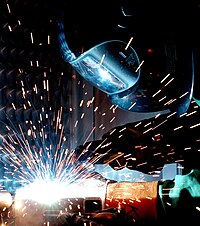
Photo from wikipedia
Particle field measurement is an important topic in many industrial branches. However, there are always complex imaging scenes in the engineering experiments, resulting in severe imaging artifact, noise, and blur,… Click to show full abstract
Particle field measurement is an important topic in many industrial branches. However, there are always complex imaging scenes in the engineering experiments, resulting in severe imaging artifact, noise, and blur, such as the optical holography. In this article, we propose a primary-auxiliary coupled neural network (PANet) for 3-D holographic particle field characterization, which can obtain a comprehensive particle measurement, including the identification, focus determination, segmentation, and size estimation. PANet is constituted by two subnets that are arranged in a coupled architecture, i.e., a Primary-Net (PNet) and an AuxiliaryNet (ANet). As the main frame, PNet is designed to accomplish the detection of most particles, while ANet aims to detect the tiny particles that PNet cannot identify. We exploit an alternative training method to realize their functional differentiation and complementation. PANet is evaluated on two kinds of holographic particle field data, i.e., high-energy laser shock aluminum target and droplet breakup in high Mach shock wave. By means of semisupervised learning and a specific loss function, the effect of deficient particle labeling can be alleviated. Experimental results demonstrate that PANet can achieve excellent performance in particle field characterization, especially for those with a wide size span and complex image background.
Journal Title: IEEE Transactions on Industrial Informatics
Year Published: 2022
Link to full text (if available)
Share on Social Media: Sign Up to like & get
recommendations!